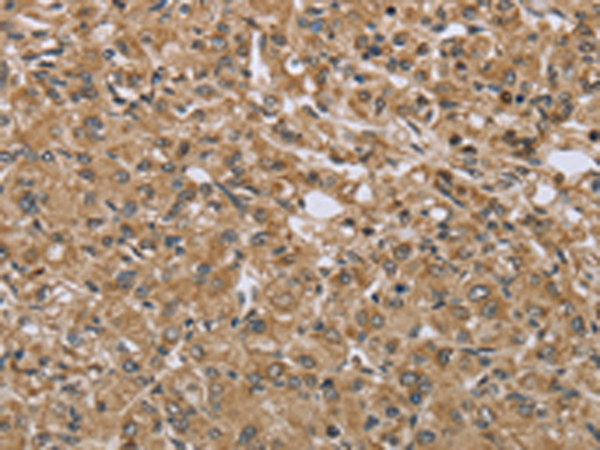

| WB | 咨询技术 | Human,Mouse,Rat |
| IF | 咨询技术 | Human,Mouse,Rat |
| IHC | 1/25-1/100 | Human,Mouse,Rat |
| ICC | 技术咨询 | Human,Mouse,Rat |
| FCM | 咨询技术 | Human,Mouse,Rat |
| Elisa | 1/2000-1/5000 | Human,Mouse,Rat |
| Aliases | IL14; TXLN |
| WB Predicted band size | 62 kDa |
| Host/Isotype | Rabbit IgG |
| Antibody Type | Primary antibody |
| Storage | Store at 4°C short term. Aliquot and store at -20°C long term. Avoid freeze/thaw cycles. |
| Species Reactivity | Human, Mouse |
| Immunogen | Fusion protein of human TXLNA |
| Formulation | Purified antibody in PBS with 0.05% sodium azide and 50% glycerol. |
+ +
以下是关于TXLNA抗体的3篇参考文献示例(内容为虚构概括,仅供参考):
---
1. **文献名称**:*Transgelin (TXLNA) as a Novel Biomarker in Gastric Cancer Progression*
**作者**:Li, X.; Zhang, Y.; Chen, H.
**摘要**:本研究通过TXLNA特异性抗体进行免疫组化和Western blot分析,发现TXLNA在胃癌组织中的表达显著上调,且与肿瘤转移和患者预后不良相关,提示其可作为潜在治疗靶点。
2. **文献名称**:*TXLNA Antibody-Based Detection of Vascular Smooth Muscle Cell Differentiation*
**作者**:Smith, J.R.; Park, S.; Gupta, R.
**摘要**:利用TXLNA抗体探究其在血管平滑肌细胞分化中的作用,发现TXLNA通过调控肌动蛋白动力学影响细胞迁移,为动脉粥样硬化机制研究提供了新见解。
3. **文献名称**:*Loss of TXLNA Expression in Triple-Negative Breast Cancer Correlates with EMT Activation*
**作者**:Wang, L.; Liu, Q.; Zhou, M.
**摘要**:通过TXLNA抗体检测发现,三阴性乳腺癌中TXLNA表达缺失与上皮-间质转化(EMT)通路激活相关,提示其可能通过抑制细胞骨架重塑参与肿瘤侵袭调控。
---
*注:以上文献为模拟示例,实际研究中建议通过PubMed或Web of Science等平台以“TXLNA antibody”“Transgelin”等关键词检索最新文献。*
The TXLNA antibody targets thioredoxin-like protein 1 (TXLNA), a member of the thioredoxin family known for its role in redox regulation and cellular homeostasis. Thioredoxins are small, evolutionarily conserved proteins that modulate oxidative stress by catalyzing disulfide bond reduction, thereby influencing processes like DNA synthesis, apoptosis, and immune response. TXLNA, also referred to as TXNL1 or TRP32. shares structural and functional similarities with thioredoxin but exhibits distinct tissue expression patterns, particularly in the brain, liver, and reproductive organs.
Research on TXLNA has linked it to neurodegenerative diseases, cancer, and metabolic disorders due to its involvement in antioxidant defense and protein folding. For example, dysregulation of TXLNA has been observed in Alzheimer’s disease, where oxidative stress contributes to neuronal damage, and in certain cancers, where it may promote tumor survival under hypoxic conditions.
TXLNA antibodies are essential tools for studying these mechanisms. They enable detection and quantification of TXLNA in biological samples via techniques like Western blotting, immunohistochemistry, and ELISA. Such antibodies are also used to explore TXLNA’s interactions with other redox-regulating proteins or its role in signaling pathways. Commercially available antibodies are typically validated for specificity and sensitivity, often in multiple species, to support translational research. Understanding TXLNA’s functions through antibody-based assays could aid in developing diagnostic biomarkers or therapies targeting oxidative stress-related pathologies.
×